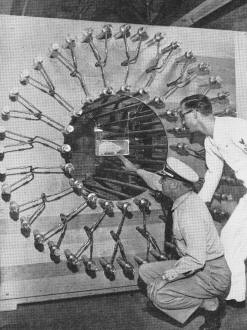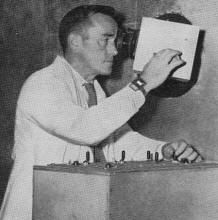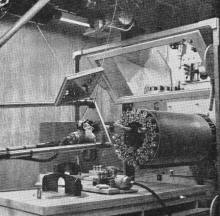| January 1953 Popular Mechanics |
 [Table of Contents] [Table of Contents]
Wax nostalgic about and learn from the history of early
mechanics and electronics. See articles from
Popular Mechanics,
published continuously since 1902. All copyrights hereby acknowledged.
|
Nearly everyone has seen
photos and/or videos of the
Operation
Crossroads nuclear weapons tests at the Bikini Atoll from shortly after the
end of World War II. Upon the ships were penned various species of animals
- goats, pigs, rats, guinea pigs, etc. - along with radiation and mechanical measurement
equipment. The goal was to determine exposure levels to nuclear and electromagnetic
radiation, as well as to severed physical forces. That was for both the ship and
its "crew." A Fat Man type fission bomb was detonated underwater (90-foot depth),
as opposed to the air drop type. Many sources provide details of the entire operation,
including the findings. Given the extreme complexity and risks involved in using
bombs, laboratory facilities were constructed to simulate exposure from bombs. This
"Death-Ray Chamber Tests Atom Effects" story from a 1953 issue of Popular Mechanics
magazine describes one method used by the Naval Medical Research Institute.
Death-Ray Chamber Tests Atom Effects

Radiation chamber is a cylinder within a cylinder. "Hot" cobalt
inside tubes permits even radiation not possible with present X-rays or radium.

Operator standing outside concrete-encased exposure rooms manipulates
controls of robot magnetic arm to insert cartridges of cobalt in pneumatic tubes.

Arrangement of mirrors enables operator to see what he's doing.
There are 60 tubes in all; each has to be loaded separately. Rays in loading room
can kill.
Packed with the killing power of half the radium on earth, a radiation chamber
for test animals is lined with tubes through which shuttle samples of radioactive
cobalt. The animal, which may be a pigmy mouse or a fat pig, is suspended in a cage
in the middle of a tube-lined cylinder. In an adjoining exposure room, a robot magnetic
arm operated by remote control picks up "hot" capsules of cobalt one by one and
shoves them into pneumatic tubes. Carried through the tubes which form the "death
cylinder," the cobalt shuttles back and forth, soaking the animal with rays from
all directions. With the machine, scientists at the Naval Medical Research Institute
can simulate the effects of atom-bomb radiation on the human body. The experiments,
they hope, will lead to better methods of treating radiation sickness and may point
the way to a means of defending the body from the deadly rays.
Posted December 5, 2023
|